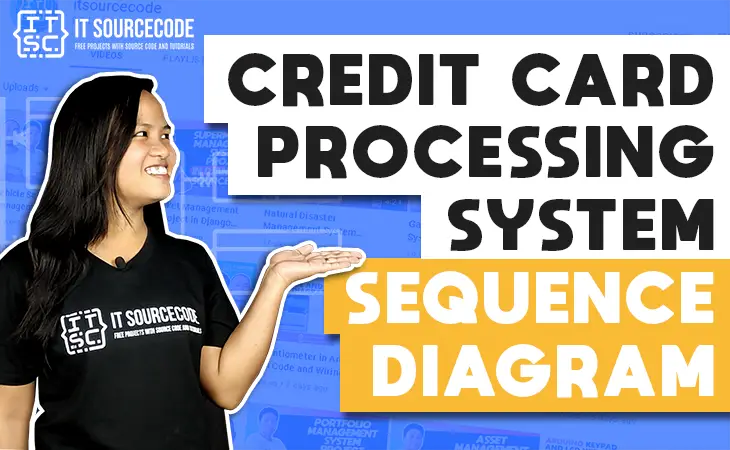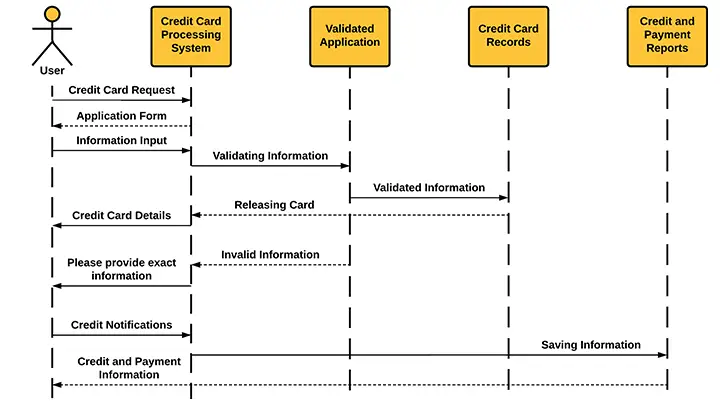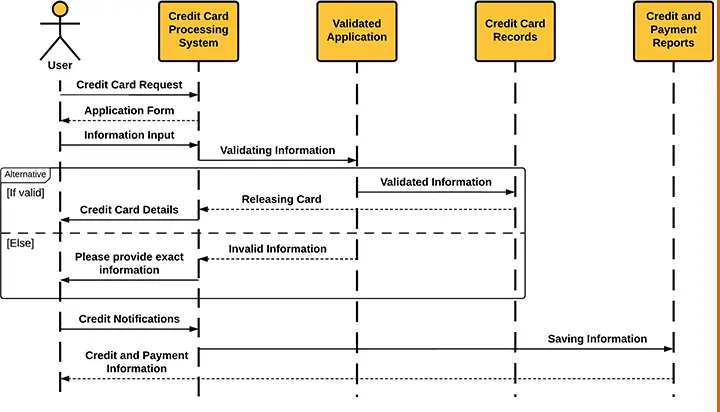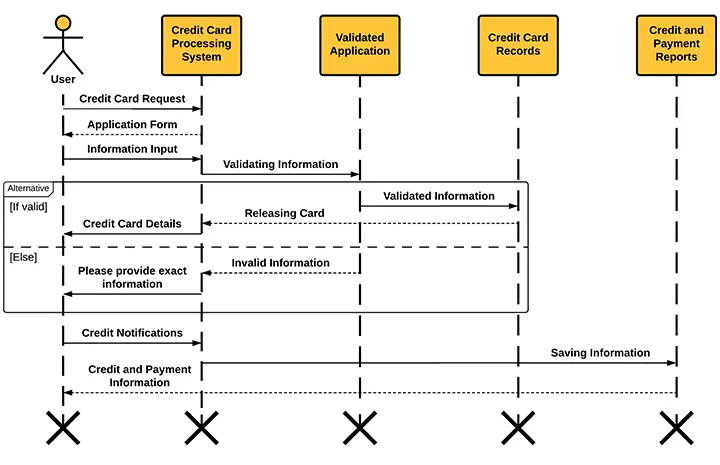Credit Card Processing System Sequence Diagram
The Credit Card Processing System Sequence Diagram describes the series of interactions that occur with the objects when performing the system’s process. A sequence diagram is one of the UML models used for presenting the workflow, sequence of messages, and interactions within the credit card processing system.
Sequence Diagram for Credit Card Processing: Table of Contents
- Credit Card Processing System Sequence Diagram
- Credit Card Processing System Sequence Diagram: Project Details
- What is UML Sequence Diagram?
- Credit Card Processing System Sequence Diagram Description
- Sequence Diagram for Credit Card Processing System (Illustration)
- Credit Card Processing System Sequence Diagram (Explanation)
- Sequence Diagram for Credit Card Processing Diagram (Pdf)
- Advantages of Sequence Diagram
- Steps in Developing Sequence Diagram
- Additional Knowledge
- Conclusion
- Related Articles
- Recommended Articles
- Inquiries
Credit Card Processing System Sequence Diagram: Project Details
The table shows the project name and details of the sequence diagram for credit card processing system. It has the complete details of the project.
| Name: | Credit Card Processing System Sequence Diagram |
| Abstract: | The sequence diagram for credit card processing system represents the scenario and the messages that must be passed between objects. It’s an interaction diagram that shows how activities are carried out, including when and how messages are sent. |
| UML Diagram: | Sequence Diagram |
| Users: | Bank and Lending Crews or Admin and Clients |
| Tools Used: | Diagram tools that provide sequence diagram symbols. |
| Designer: | ITSourceCode.com |
What is UML Sequence Diagram?
In software engineering, the UML sequence diagram depicts object interactions in a sequence of events. This diagram shows the credit card processing scenario and how they communicate with each other to function correctly.
According to lucidchart.com, a UML sequence diagram helps software engineers and business experts figure out what the project should perform and how to describe a process that is already in place. It’s a form of interaction diagram since it shows how a group of things interacts and in what sequence.
A sequence diagram is a useful tool for documenting a system’s needs and fleshing out its architecture. Because it depicts the interaction logic between the items in the system in the time order in which they occur, the sequence diagram is quite valuable.
What is a Credit Card Processing System?
Credit card processing is a multi-step process that is required to correctly complete credit card payments. In today’s digital age, transactions can take place in person, online, over the phone, or through the mail. Several entities are involved in credit card processing.
A credit card processing system is software that provides aid in a complicated business with many moving pieces: new technology, payment networks, regulatory authorities, and financial institutions. Credit card processors, like any service involving that level of sophistication, vary in quality.
Credit Card Processing System Sequence Diagram Description
The sequence diagram is used to look at the behavior of multiple objects within the credit card processing system. Sequence diagrams are good for showing how objects work together and in what order the events occur. It shows objects that communicate within the processing system, with messages going from them to each other down the process in a certain order.
The credit card processing system uses a sequence diagram to show how objects interact and how they happen sequentially. This sequence diagram shows how messages move from one object to another in a way that makes sense.
Sequence Diagram for Credit Card Processing System (Illustration)
The designed sequence diagram for credit card processing system gives you the exact scenario when the project is in use. This design presents the actual sequence of events and interactions between the user and the project. It uses symbols to represent the included objects and their roles in the credit card processing system sequence diagram.
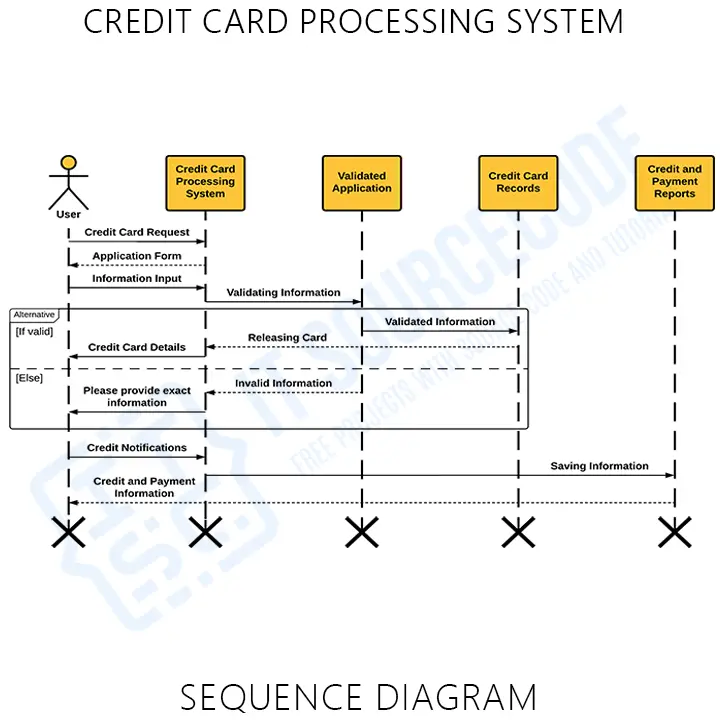
The illustration is based on the main process of the credit card processing system. It can still be modified and added with your desired functions and scenario. It is straightforward and sticks to the idea of registering student information for a specific course through a credit card processing system.
Credit Card Processing System Sequence Diagram (Explanation)
The explanation for the credit card processing system discusses how the illustration works. It has the figures which will clarify the sequence of activities and their alternatives. The box figures represent the object, the stick man is for the user, and the broken lines are for the lifelines. Messages are then presented by vertical arrows.
The sequence diagram is designed to portray a timeline that starts at the top and gradually lowers to show the sequence of interactions. Each item has a column, and arrows indicate the messages that are sent between them.
The credit card processing system sequence diagram has several boxes (objects) which are the credit card processing system, validated Information, credit card information, and credit and payment reports. Its user is the card applicant and holders.
Sequence Diagram for Credit Card Processing Diagram (Pdf)
You may download the Sequence Diagram for Credit Card Processing System PDF by clicking the button below. It has the full details and discussion of the system’s sequence diagram. You can also modify its content to complete your project requirements and needs.
Advantages of Sequence Diagram
The UML sequence diagrams are commonly used by developers to model the interactions between components in a single-use case. They show how the various components of a system interact to perform a function, as well as the order in which the interactions occur when a certain use case is executed. here are the advantages of designing a sequence diagram:
- A sequence diagram depicts the timeline and order in which messages are sent between devices to carry out process functions.
- Sequence diagrams are based on objects rather than classes.
- Used to step-by-step model a system’s process.
- Sequence diagrams are a great way to model the dynamic properties of your system.
- It aids programmers in determining the overall message flow between objects that perform use-case logic.
Steps in Developing Sequence Diagram
Time needed: 10 minutes
Here’s the complete guide and steps in developing and designing your sequence diagram for the credit card processing system.
- Finalize the purpose of the project
The first step in doing your sequence diagram is to finalize what your project is all about. The credit card processing system portrays the idea of registering the student’s information into the course that they want. Then this idea will give you other initiations on what to include in the project.
Take note that you as the developer and your client (if there is one) can decide on what functions and features should be included in your project. It’ll include anything as long as the function or feature is related to the idea of your project. - Place your users or objects
The project users in the sequence diagram will always be based on your targeted users. You can create a design for each of your users or put them all in one design. Just be mindful of having a clear and precise illustration.

The object, on the other hand, is represented by a rectangle with the object’s name underlined. The object name, the object name, and its class, or only the class name can all be used to name an object (anonymous object).
The sequence diagram depicts a group of objects connected by lifelines as well as the messages they exchange over time during the interaction. - Add the lifelines in each user and object
A lifeline represents each instance of interaction. As it moves downhill, it represents the passage of time. Broken vertical lines show the next events that happen to an object during the charted process. A named rectangular shape (object) or an actor symbol is used to start Lifelines.

The lifeline sequence diagram is symbolized by a broken line connected to its head (object) that represents the lifetime of the object. - Structure the sequence of messages (interaction)
A message is a representation of communication between objects or between an object and its surroundings. An event, a triggered operation, or a primitive operation are all examples of messages. A message in the metamodel denotes a certain sort of communication.

In UML diagrams, messages are represented as labeled arrows, with the arrowhead indicating the call’s direction. When a message is sent to an object, the name of the method being called on the receiving object is indicated in the text associated with the message.
In a sequence diagram, a message is a named element that describes one sort of communication between interaction lifelines. The message not only describes the form of communication, but also the sender and receiver. Usually, two things happen the transmitter and the recipient (the points at the ends of messages). - Add alternatives (if needed)
When a scenario needs to choose between two or more message sequences, the alternative combination fragment is employed. It represents the logic of “Otherwise, if. One way for distinguishing which fragment is which “operator for fragments” is to put “alt” in the name box of the frame, also known as the “frame name box.

Different process conditions are denoted by the term “alt. Only one of the options will be implemented. The term “opt” means a workflow phase that can be skipped. - Add the X symbol as the lifeline end
When the object’s lifeline is completed, you can add an X to the end of it to indicate that it has been destroyed. A rectangle represents a recurrence or loop in a sequence diagram.

Additional Knowledge
A sequence diagram is a useful tool for documenting a system’s needs and fleshing out its architecture. Because it depicts the interaction logic between the items in the system in the time order in which the interactions occur, the sequence diagram is quite valuable.
It is a type of interaction diagram that depicts objects as lifelines running down the page, with messages rendered as arrows from the source lifeline to the target lifeline to describe their interactions through time. Complex procedural logic is not intended for sequence diagrams.
Conclusion
You need to know the diagrams used to design and develop the Credit Card Processing System. That is because you cannot perfectly create a fully-functional system without it. But if you create this sequence diagram, you will know the series of processes and interactions that implies the system’s function. A sequence diagram guides the programmers with the system’s behavior through its’ interaction diagram.
The sequence diagram is used to model the system’s sequence of events. It describes the interaction between the users and the system. By completing the Diagrams per module or process, you will easily achieve your desired system. Check out our Related and Recommended Articles for more Learning and Information.
Related Articles
- Sequence Diagram for Course Registration System
- Sequence Diagram for Face Recognition Attendance System
- University Admission Management System Sequence
- Online Food Ordering System Sequence Diagram
- School Management System Sequence Diagram
Recommended Articles
Inquiries
If you have inquiries or suggestions about Credit Card Processing System Sequence Diagram, just leave us your comments below. We would be glad to hear to concerns and suggestions and be part of your learning.

